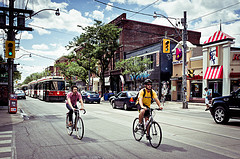ChangeEngine’s irrepressible blogger on all things urban, Lindsey Davis of The Good Plan, got a shout-out today from the good people over at Livability — an online hub for cities that punch above their weight — in their weekly round-up of all ideas spiky and intriguing. When alerted to this fact, Lindsey went into what might be described as paroxysms of enthusiastic analysis, producing a set of pithy, punchy, point-by-point responses that bears an uncanny resemblance to Fisking. (“Ooo new word!” says Lindsey.)
So, as a kind of capper of our own on the week, we present Lindsey’s rapid-fire reactions to Livability’s weekly round-up, with a focus on demographer Joel Kotkin’s provocative suggestion that the suburbs, not San Francisco, might be the template for the future of the American city:
“Could urban sprawl be the best indicator or future city growth? Many urban planning theorists prescribe the idea of high density and central cores as the best way for cities to grow…”
-High density and central cores are the “Best way for cities to grow”? No! Smart development of high density and central cores are the best way for cities to grow.
“…but then there’s Joel Kotkin, a demographer who says data shows legacy cities are a model of the past and that the cities of the future will resemble those experiencing more outward growth.”
-Legacy cities are a model of the past and the future will resemble outward growth. Shocker. So alternately, legacy cities would be forgotten, we’d start ALL over in some field somewhere, build brand new infrastructure? Well, yes. Legacy cities are a model of the past YET A FOUNDATION FOR OUR FUTURE DEVELOPMENT BECAUSE HALF THE WORK IS ALREADY DONE. And yes, we’ll have to move out. We certainly can’t keep going up. Unless you live in Hawaii that is.
“Are Sprawling Urban Regions The Next Great Cities?”
-Are sprawled regions the next great cities? I mean, what’s the alternative here. Something has to be ‘new’ and ‘next.’ If we’re making ‘new’ cities I would think we’d place them in an area where economic activity exists. Also, how are we defining a city? Is the word ‘city’ becoming clichéd? Just like “innovation”… (cue dramatic sigh).
“Kotkin says low-density, car-dominated, heavily suburbanized areas with small central cores are likely the next wave of great American cities.”
-I absolutely agree with Kotkin in that low density, car-dominated areas are next. The infrastructure exists, moveable people exist, we’d be more likely to start corralling businesses there than go to a field and build a utopian city with bicycle lanes adjacent to tractors.
“He cautions ‘urbanistas’ to wake up and recognize that the future is going to look more like Houston, Charlotte and Phoenix and less like Boston, Chicago or San Francisco.”
-Well, I don’t think the future will look like Charlotte or Houston. The next cities might, but think of it in stages – we have to enter stage one car domination before evolving to city 2.0 with bikes and trams and transit. Its easier to take people who live somewhere and make them dense and miserable and then make their lives easier via light rail, than to build a light rail in middle of nowhere Nebraska and then expect people to move there.
“The best practice for fixing a city’s problems might be staying away from the best practices. Things that make one city livable may not work in another city. That’s the point Lindsey Davis, a city planner and blogger, makes in a recent post about best practices for cities.”
-OMG! THAT’S MY NAME! OMG!! AH! I’m KVELLING! AH!
Stay tuned for the next installment of The Good Plan, where Lindsey will take on Kotkin’s thesis in more detail, though with perhaps a touch less kvelling.

